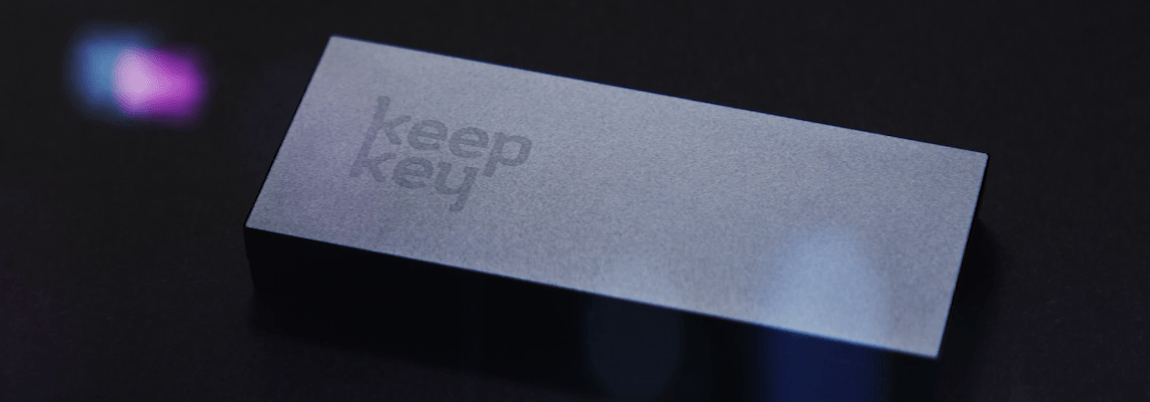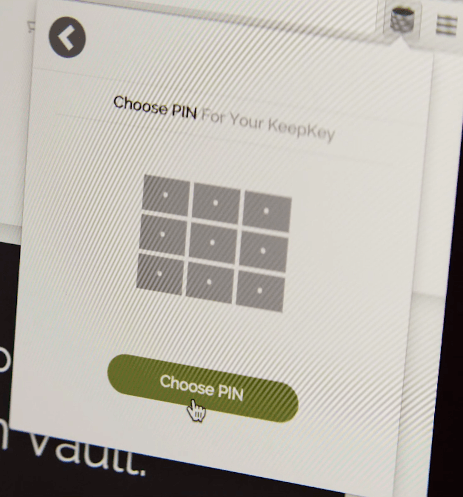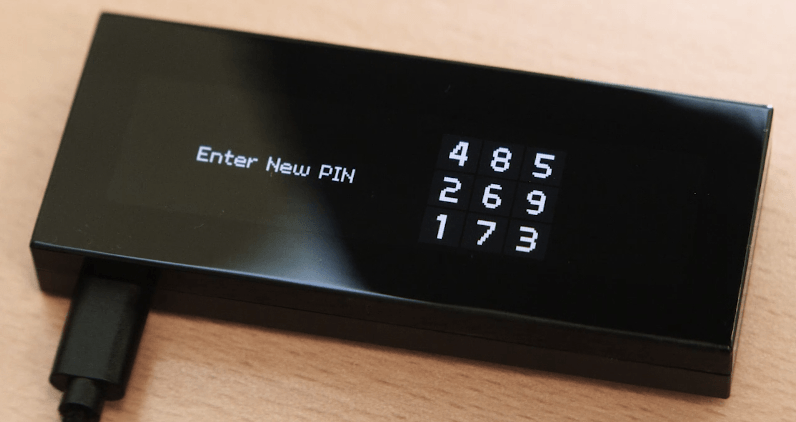The KeepKey hardware cryptocurrency wallet is one of the newer additions to the world of hardware wallets for storing Bitcoin and other cryptocurrencies. Currently the wallet can be used to store Bitcoin, Bitcoin Cash, Ethereum, Litecoin, Dogecoin, Testnet, DASH, and Namecoin. This isn’t a huge list of coins, and other hardware wallets can support a broader variety of altcoins, but it is a good selection of the most heavily traded coins. Note too that in February 2018 KeepKey announced support for ERC-20 tokens in the beta version of its client. The first coins being supported are SALT, Aragon, Augur, BAT, Civic, Golem, Gnosis, OmiseGO, District0x and FunFair.
It should also be noted here that since KeepKey was acquired by ShapeShift in August 2017 the wallet supports automatic exchange of supported coins through the ShapeShift API.
KeepKey has several similarities as well as several differences when compared with other hardware wallets such as the Trezor or Ledger Nano S, so a full review will be helpful to you when comparing the hardware wallets and deciding which one best suits your needs. Once you finish this KeepKey review, feel free to make your own comparison and decision by reading both our Trezor review and our Ledger Nano S review.

KeepKey Security Features
Because the main function of a hardware wallet is keeping your Bitcoin and other coins safe and secure, the first thing we want to look at in any hardware wallet is the security features offered. As far as that goes, the KeepKey has all the features you look for in current hardware wallets to keep hackers and thieves far from your Bitcoins.
If you expect top-notch security for your cryptocurrencies, that’s what you’ll get from the KeepKey, with protection not just from virtual attacks, but from physical attacks as well. And when using it, the private keys never leave the device, so it can even be used on a computer that is malware infected or hacked.
You can think of the KeepKey as its own tiny self-contained computer, designed and built specifically to store Bitcoin and other cryptocurrencies safely and securely.
So, you get offline storage of your coins, and levels of protection. The physical protection comes from the KeepKey PIN codes, and the number randomization feature.
Further protection from physical access to the device is provided because KeepKey is a hierarchical deterministic wallet, which allows for a backup/recovery seed of 12, 18, or 24 words to be created when setting up the wallet. This seed is generated using entropy not only from the KeepKey itself, but also from the computer that is used during setup.
In order to keep the seed phrase itself secure it is generated offline, and is only displayed on the KeepKey screen. This ensures that your backup/recovery phrase is never exposed to the internet. Be sure to write it down and keep it in a safe place, as you’ll need it to recover your coins if your KeepKey is ever stolen, lost, or destroyed.
If such an unfortunate event were to occur you could use the backup seed and KeepKey’s Chrome extension to quickly and easily restore your wallet and all the coins contained within it.
The KeepKey screen provides additional security by helping you confirm you’re sending to the correct recipient, but remember it doesn’t stop phishing attacks, only your own vigilance can do that.
Secure Packaging
Right from the time your KeepKey is delivered to your house you’ll see that security is taken seriously. The package is not only shrink wrapped, but is also sealed with a printed KeepKey seal that proves no one has opened the package before you. Inside the box you’ll find the KeepKey hardware wallet, a USB cable to connect your KeepKey to a computer, a card for recording your recovery seed, a leather case for storing that card, and instructions for configuring the KeepKey for the first time.
PIN Protection
The KeepKey uses the same method for PIN creation as the Trezor, which keeps hackers and keyloggers from being able to compromise your PIN. Basically the keypad for displaying the PIN is on the KeepKey device, with the numbers randomly scrambled. The actual input is done in the browser software extension, with the numbers grayed out. This means there is no way for a hacker to know what numbers you are actually inputting for your PIN.

Recovery Seed
When you first set-up the KeepKey it randomly generates a 12-word recovery passphrase. This allows you to recover your coins if the KeepKey is ever broken or stolen. It also keeps thieves and hackers from ever recovering your coins. And while the 12-word keyphrase is the default, you can specify a longer 18 or 24-word phrase during setup for added security. Always keep your recovery seed in a safe place, as you could lose all your coins if your KeepKey were lost, damaged or stolen and you no longer had the recovery seed.
Passphrase Protection
The KeepKey has the ability for you to add your own passphrase to further secure the device from bad actors. The passphrase is an additional word appended to your recovery sentence that is never stored on your KeepKey. No one will ever know your passphrase unless you tell them what it is. This is an excellent feature that further secures your coins from theft.
Secures Your Private Keys

KeepKey generates a private key using its hardware-based random number generator, combined with randomness provided by your computer. It then works with the wallet software on your computer by taking over the management of private key generation, private key storage, and transaction signing. Your private keys remain on the KeepKey device, keeping them secure at all times. And because the KeepKey is PIN protected there is no way for anyone to access your keys, even if they steal your KeepKey.
Secures Your Transactions
Transaction signing is also done on the KeepKey device. Each transaction must then be approved by physically pressing a button on the KeepKey. Even if a transaction were spoofed by a hacker there would be no way for them to send it because there is no way they could physically press the button on the KeepKey. Plus the KeepKey is immune to malware and viruses because it works offline and without software.
KeepKey Product Details
The KeepKey is somewhat larger than other hardware wallets, but this means its screen is also easier to read. While this also means the KeepKey isn’t as easy to carry around with you, it’s still small enough to carry if you must. And since hardware wallets are really most suited to cold storage of your Bitcoins and other coins, you shouldn’t need to carry it with you most times.
If you do want to take the KeepKey along with you when you’re traveling you certainly can, and because it uses flash memory it is safe to take through airport x-ray devices. Note that the KeepKey is made of metal and will set off metal detectors.
The KeepKey will work with Windows, OSX, Linux and Android operating systems, and so it can be used with most modern computers as well as Android tablets and smartphones. It uses a custom chrome browser extension as a software wallet, and can also be used with Electrum and MultiBit HD. In addition, KeepKey is a USB HID-class device (like keyboards, mice, and game controllers). It doesn’t require drivers when used on Windows, Mac, or Linux.
In Conclusion
The current generation of KeepKey is sufficient for safely storing your Bitcoins and the other coins supported, and with a price tag of $99 it’s price competitive with both the Trezor and Ledger Nano S. Any of the three should give you good protection from the threat of theft, which is important as hackers become increasingly canny. The KeepKey has continued to develop and improve, and with ERC-20 tokens being added, and the lower price now as compared to last year, the KeepKey should soon be moving up the ladder in terms of hardware wallet market share.